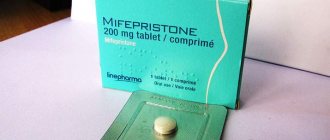Empty follicle syndrome
Empty follicle syndrome is a diagnosis that is increasingly encountered by married couples who have been trying to conceive a baby for a long time. This pathology is usually detected during infertility examinations. Usually these are diagnostic techniques such as ultrasound, various laboratory tests, etc.
The most accurate information is provided by follicular fluid analysis, which is carried out only at the level of in vitro fertilization. According to doctors, it is with the help of this type of examination that it is possible to identify the disorder, although it sometimes gives unreliable results. However, not all doctors recognize the fact of such a pathology. For what reasons this happens, we will consider further.
Follicle studies
Many tests have demonstrated that the use of a GnRH agonist trigger in medicine instead of hCG allows one to obtain the desired oocytes. This is because the administration of GnRH agonist promotes a large amount of FSH release, which leads to cumulus enlargement and oocyte nuclear maturation. Also, this hormone stimulates the appearance of plasmin in the follicular fluid, which further develops collagenase, rupturing the follicle wall.
For a long time, there have been discussions regarding whether women will be able to get pregnant if the methods of producing oocytes are unsuccessful. Previously performed diagnostics included 3004 follicle punctures. All patients were divided into 2 large groups. One contained women who had only a single case of SPF, and the other had more than one.
Previously, all patients underwent reproductive system studies, which included checking basal temperature, hysterosalpingography and post-coital test. Infertility of an unexplained syndrome was confirmed when all of the above indicators were normal, and laparoscopy showed that no pathology was detected.
Doctors previously diagnosed 200 IVF cycles and 35 women. In 90% of cases stimulation was performed. In group 1, 137 cycles were performed, and in the second, 63. The SPF for some was 19.7%, and for others, 44.4%.
The studies were conducted on patients whose ages ranged from 25 to 48 years. It was determined that in girls from two groups under the age of 34 years, the only cycle was SPF. In women aged 35 to 39 years, repeated SPF cycles were seen in 23.5%. In patients over 40 years of age, SPF was observed to be 57%.
Pregnancy occurred only in those who had SPF once. Based on the studies conducted, it was noticed that a woman’s age largely affects the number of oocytes formed and the effectiveness of IVF.
Why are follicles empty?
In the female reproductive system, germ cells for fertilization are produced every month. But sometimes there are malfunctions in the functioning of this well-functioning mechanism, since the body needs rest. Therefore, the onset of anovulatory cycles, in which the dominant follicle does not mature, once or twice a year is considered normal. In some cases, the follicles are empty.
The older a woman is, the more often she experiences anovulatory cycles (mainly after 30 years). With age, the production of sex hormones decreases, and therefore the likelihood of becoming pregnant is lower. Doctors explain the maturation of empty follicles for several reasons. In the human body, the activities of all organs are interconnected, and the growth of eggs is primarily ensured by signals from the brain. But this process is also affected by other organs, for example, the adrenal glands and ovaries.
One of the most common reasons for the appearance of empty follicles in the ovaries is a violation of the production of sex hormones.
So, the main reasons for the production of empty graafian bubbles:
- Obesity.
- Early aging of the ovaries.
- Hereditary predisposition.
- Premature menopause.
- Polycystic disease.
- Adhesive processes.
- Endometriosis.
- Systematic heavy emotional stress.
Stress has a particular impact on female fertility. Women by nature are very sensitive and emotional, and any unfavorable situations (conflicts, quarrels, various unrest) negatively affect reproductive function. A signal is sent from the brain that blocks the growth of oocytes, resulting in mature follicles being empty.
Usually, after restoring emotional balance, eliminating concomitant pathologies and creating comfortable psychological conditions, the problem resolves on its own. It is much worse when Graafian vesicles still remain empty even after hormonal stimulation of the ovaries.
Risk factors for the appearance of follicles without an egg
Empty follicle syndrome became known more than thirty years ago. This diagnosis was first described by Caroline Colam, who determined that the failure of pregnancy in some cases may be due to the absence of oocytes in the graafian vesicles. But why this happens, the doctors of that time could not explain. Just like modern ones. But doctors have identified several risk factors for the appearance of empty follicles:
- Aging of the ovaries.
- Turner's disease. This is a rare pathology in which the female body does not produce eggs at all.
- Introduction of a low-quality chorionic gonadotropin drug (hCG drugs are used to ensure that the follicle releases the egg in a timely manner).
- Untimely administration of the hCG drug (earlier than 36 hours before ovulation, or, conversely, later). In such cases, the egg simply does not have time to mature, or the follicles develop into cysts when they are late.
- Incorrect dosage of drugs based on human chorionic gonadotropin.
- Early ovulation.
- Hormonal disorders resulting from an overdose of drugs prescribed in the protocol.
- Mistakes during ovarian stimulation.
- The body's immunity to hCG.
- Improper development of the egg.
- Physical and psychological stress.
- Sleep problems.
- Unbalanced unstable nutrition.
- Problems in follicle development.
There are cases in which all risk factors are excluded, but the follicles are still left without eggs. There is no medical explanation for this. The process of maturation of germ cells is influenced by a large number of external and internal factors. Therefore, reproductive doctors do not consider empty follicle syndrome a separate disease. In addition, this diagnosis cannot be confirmed using conventional techniques, such as ultrasound.
The intensive development of cell biology and clinical pharmacology has made it possible to improve methods of overcoming infertility. However, a number of problems remain that cannot be explained or solved. One of them is the “empty” follicle syndrome (EFS), which is often unpredictable and therefore, according to F. Lok [1], a “disarming” event.
SPF was first described in 1986 by American scientists S. Coulam et al. [2]. According to domestic and foreign literature [3–7], published from 1986 to 2012, the incidence of the syndrome ranges from 0.25 to 7%.
The attitude towards the concept of “empty follicle syndrome” is still ambiguous. Thus, some authors [8, 9] deny its existence, others [4, 10–16] believe that SPF is only a sporadic event, and still others [7, 17–29] characterize it as an independent dysfunctional condition with a high probability of relapse in subsequent cycles. At the same time, there is no doubt about the relevance of the problem, which is associated with understandable economic and emotional costs.
Today, SPF is understood as the absence of oocytes during transvaginal puncture (TVP) of follicles (even with repeated washings) in IVF programs with normal characteristics of folliculogenesis and steroidogenesis during ovarian stimulation [10, 19, 30-32]. In a systematic review by T. Stevenson et al. [33] SPF is divided into true and false [8, 12, 16, 34]. True SPF means the impossibility of obtaining oocytes from mature follicles at optimal serum concentrations of the β-subunit of human chorionic gonadotropin (β-hCG) on the day of puncture [4, 32, 33], false SPF was a consequence of the influence of the human factor [8, 16, 33, 34]. About 67% of all cases of SPF were the false form [33]. According to T. Mesen et al. [7], only 2 (0.016%) cases out of 12,359 cycles can be attributed to true SPF.
An alternative classification of SPF into sporadic and absolute forms (based on the principle of repetition in subsequent IVF cycles) was proposed by domestic researchers [37].
Some authors identify the so-called borderline form of the syndrome, in which, with successfully completed TVP, degradation of cumulus-oocyte complexes is subsequently observed during denudation [27], oocyte degeneration [38] or lack of fertilization [39, 40].
To date, the etiology of SPF is unclear. S. Coulam et al. [2] associated it with infertility of unknown origin. However, SPF has been described in various forms of infertility [32].
There are several main possible causes of SPF:
— iatrogenic (human factor);
- pharmacological;
- genetic;
- ovarian.
It is known that the percentage of oocyte aspiration during TVP of follicles, even when using the washing technique, averages 80 [41, 42]. A. van Heusden et al. [9] when analyzing 14 IVF cycles with established SPF, they calculated that the probability of failure to obtain at least one oocyte was 0.064–4%, which corresponded to the overall prevalence of the syndrome. The results of the study served as an argument for the assertion that SPF is solely a consequence of the doctor’s insufficient experience, technical difficulties or features that arose during the TVP procedure [9, 12, 43]. The assumption about the significance of the human factor in the genesis of the syndrome has been supported by many researchers. Possible causes also discussed include: poorly controlled superovulation stimulation (CSOS) [22], incorrect timing of hCG administration [24, 44], insufficient patient instruction [14], untimely administration or omission of an ovulation trigger injection [12, 15, 26, 35]. , 45, 46].
There is an opinion [16, 45, 47] that the appearance of SPF is associated with the use of hCG drugs in ovarian stimulation protocols. Discussions on this topic began in 1995, when F. Zegers-Hochschild et al. [16] found that the absence of oocytes during TVP in patients with SPF is due to rapid clearance and insufficient exposure to hCG. Proponents of the “pharmacological hypothesis” explain the occurrence of the syndrome by the low bioavailability of hCG drugs associated with defects in storage, production, packaging and preparation [6, 21, 34], as well as individual characteristics of drug metabolism [8].
There is evidence in the literature about the genetic causes of SPF. Thus, G. Onalan et al. [17], who described the recurrence of SPF in three IVF cycles in sisters suffering from hereditary hearing pathology, suggested that genetic factors associated with infertility and hearing impairment play a role in the etiology of the syndrome. In 2005, K. Yariz et al. [20] stated that the lack of effect of the introduction of an ovulation trigger and, as a consequence, the occurrence of SPF was the result of the presence of a homozygous mutation (LHCGR, p.N400S) in the luteinizing hormone receptor gene. In 2011, S. Vujisic et al. [23] when analyzing the karyotypes of patients with repeated SPF, revealed the presence of pericentromeric inversion of chromosome 2 - 46 XX inv (2) (p11q21).
Some authors [3, 14, 16, 19, 27, 32, 37] believe that damage to the mechanisms of normal folliculogenesis plays a major role in the occurrence of the syndrome. In addition, an atypical reaction to the introduction of an ovulatory dose of hCG is discussed - late maturation or early atresia of the cumulus-oocyte complexes [22, 32], infectious factors (chlamydial infection) [30], as well as idiopathic dysfunction of the ovaries [37]. The main argument in favor of these hypotheses are the results of microscopic examination of the follicular fluid of patients with SPF. Thus, N. Desai et al. [19] during its analysis discovered cumulus-oocyte complexes that do not contain an oocyte (“empty”), N. Duru et al. [27] - single immature cells (at the stage of germinal vesicles) [27], and T. Vutyavanich et al. [32] - small structures consisting of 2-3 layers of granulosa cells surrounding the immature oocyte.
An attempt to deepen our understanding of the mechanisms responsible for the occurrence of SPF was made by M. Inan et al. [28], who studied the expression of 160 genes in granulosa cells of patients with this syndrome. The authors concluded that the absence of oocytes during puncture can be explained by impaired expression of genes responsible for apoptosis, proliferation and cell differentiation (decreased transcription of mitogen-activated protein kinase 3, phospholipase A2 and transforming growth factor II). A number of works [3] aimed at studying the role of the ovarian factor in the development of the syndrome are devoted to the biochemical analysis of follicular fluid. Thus, it was found that the concentration of prolactin, hCG, insulin-like growth factor-1, as well as the activity of peptide hydrolases in follicle aspirates from patients with SPF are lower than those in patients without SPF [3, 42].
In the literature there are also descriptions of cases of the occurrence of the syndrome, the causes of which are interpreted as difficult to explain. Thus, K. Stefunidis et al. [44] did not obtain oocytes from TVP of mature (12) follicles in a patient with ovarian torsion. The authors suggested that a decrease in blood supply and the development of local venous and lymphatic stasis could cause a violation of folliculogenesis. J. Hirshfeld-Cytron et al. [48] identified SPF in a patient who had undergone plastic surgery due to obesity before entering the IVF program. In this case, the occurrence of the syndrome could be due to a decrease in the absorption of drugs, including hCG, associated with a reduction in subcutaneous fat. In the work of H. Qublan et al. [49] describes an idiopathic case of ovarian pregnancy that occurred after an IVF cycle that was interrupted due to the lack of oocytes at the stage of TVP.
Diagnosis of the syndrome is retrospective, characteristic features of IVF cycle indicators in patients with SPF are absent, and the reliability of prognostic markers is debatable [3, 4, 7, 9, 31, 37, 42, 51]. Possible risk factors for the development of SPF include: patient age (over 37 years), duration of infertility (more than 8 years) [5], overweight and obesity [50], as well as insufficient ovarian response to stimulation in previous IVF cycles [32] .
To date, the only generally accepted criterion for diagnosing the syndrome in ART cycles is the absence of cumulus-oocyte complexes [32] or oocytes [11] (“empty” complexes) in follicle aspirates. However, with a more thorough analysis of the follicular fluid of patients with SPF, in some cases cellular elements (immature oocytes, small structures of granulosa cells) can be identified, therefore, according to some authors [19, 32], the diagnosis of SPF can be established erroneously. In this regard, during SPF it is proposed to assess the hCG content in follicular fluid [23]. However, according to M. Rosen et al. [42], there is no reliable relationship between the level of hCG in the follicular fluid and the presence of the cumulus-oocytic complex.
Some works are devoted to ways to prevent SPF. An important role in them is given to correctly performed stimulation of ovulation [22, 44], careful education of patients [12, 14, 26, 45, 54], precise timing of trigger introduction [15, 24, 35, 46], and professionalism of staff [9, 12 , 32, 43], the use of the follicle “washing” technique [10, 25], optimal equipment and clear organization of the work of the ART department [6]. In various studies, in order to prevent SPF, it is recommended to use gonadotropin-releasing hormone agonists (a-GnRH) as a trigger [1], use recombinant hCG preparations [15, 55], change the dose of the trigger [31], combine a-GnRH and hCG [13], and also give preference to protocols with GnRH antagonists [21]. A. Hourvitz et al. [32, 39] indicate the need to use the in vitro maturation (IVM) procedure in patients with a history of repeated cases of SPF [32, 39].
It is believed that the only way to correct the syndrome when it is detected during follicle aspiration is to interrupt the procedure [4, 8, 11, 25, 26, 29, 31, 32, 35, 43, 45, 56] at the stage of puncture of the follicles of one ovary from its subsequent repetition after several [29, 57], 24 hours [3, 4, 31, 54] or 36 hours [15, 45, 58]. The authors justify the feasibility of such tactics by the need to clarify the fact that the patient violated the regime of administration of the ovulation trigger, as well as possible individual characteristics of hCG metabolism. A number of researchers propose to determine the concentration of hCG in the blood [4] after a “partial” TVP, and when low serum concentrations of the hormone are detected (according to various sources, less than 100 mIU/ml [16], 40 mIU/ml [33] or 10 mIU /ml [45]) recommend repeating the ovulation trigger injection followed by delayed oocyte aspiration [4, 8, 25, 31, 34]. However, opponents of such tactics argue that even with the optimal concentration of the hormone in the blood, repeated administration of the drug is necessary [11, 25, 29, 45, 55, 59, 60]. Despite the established effectiveness of this method of correcting SPF, a number of authors [4, 5, 29, 31, 52] indicate the possibility of relapse of the syndrome in the current cycle with repeated puncture of the follicles. There is also a likelihood of a spontaneous LH peak occurring when TVP is delayed [26], and an increased risk of ovarian hyperstimulation syndrome with repeated administration of the hCG drug [56].
Most reproductive specialists, when consulting patients diagnosed with SPF, recommend that they undergo a “new” IVF program [37, 47]. The risk of recurrence of SPF in subsequent ART cycles is not clearly defined. Some authors report its absence (study of 1849 IVF cycles) [54], others demonstrate a high percentage (16-22) of recurrence of SPF (in 15 programs in 4 patients [51]) [5, 18]), indicating an increased risk of recurrence its detection in patients of older age groups (57% for women over 40 years of age [18, 21]); others predict a “poor” ovarian response to stimulation in subsequent IVF cycles [40].
Scientists have mixed opinions regarding the fertile potential of patients with SPF.
D. Reichman et al. [4] (analysis of 17,298 IVF cycles) found that SPF is not accompanied by a decrease in the percentage of fertilization, implantation rate, clinical pregnancy both in subsequent and in the current cycle with successful correction of the syndrome. At the same time, according to S. Coskun et al. [51], (3023 women in the study), T. Mesen et al. [54] (analysis of 12,359 ART programs), SPF is manifested by a decrease in the fertile potential of patients in repeated ART cycles (pregnancy rate per cycle 6.25%). In this regard, many authors believe that this category of women should be advised about the possibility of relapse of the syndrome, the relative success of the new planned IVF protocol [5, 21, 40, 51] and the need for a timely transition to the Oocyte Donation program [3, 11, 37 ].
The analysis of the literature demonstrates that due to the lack of understanding of the etiology, the mechanisms of development of SPF, and the lack of clear tactics for managing patients with this pathology, the relevance of the problem remains, and further research is required to solve it.
Is it curable or not?
The diagnosis of an empty follicle is not a death sentence for women who plan to become mothers. Modern reproductive specialists find a way out of such situations. First of all, treatment and stimulation tactics are revised, medications are replaced with others, and the dosage is adjusted.
In addition, doctors use the method of washing the ovaries, and also lengthen the time interval between stimulation of ovulation and puncture. Usually such measures are effective, and it is extremely rare that the same patient is re-diagnosed (empty follicle syndrome). Otherwise, the use of donor biomaterial is indicated.
Follicles without oocytes are almost never found in young girls, but in older women they are diagnosed quite often. When preparing for in vitro fertilization, the doctor, as a rule, tells the patient about all possible risks and similar unexpected situations. The main thing with such a diagnosis is not to panic or despair, since changing the approach to infertility treatment usually gives positive results.
Therapy for empty follicle syndrome
Currently, treatment of SPF is challenging. A universal therapy for every patient has not yet been invented.
Some doctors advise performing standard ART cycles a second time, regardless of treatment. If GnRH agonists were used during the cycle with SPF, then the second attempt was recommended to use antagonists and vice versa. If oocytes did not have to be aspirated from one ovary when hCG was low, then some doctors advised repeating all procedures for the second ovary. Other experts recommended changing the urinary hCG drug to a recombinant one. Indeed, in two clinical cases, the patients managed to obtain oocyte maturation.
Thus, women who experience SPF may become mothers in the future if the following therapy is carried out during treatment:
- change in ovarian stimulation;
- changing medications (replacing antagonists with GnRH agonists);
- changing the dosage of medications;
- lengthening the interval between puncture and stimulation of ovulation;
- performing ovarian lavage.
If the therapy does not bring the desired result, then a woman can become a mother using a donor egg.
Treatment of empty follicle syndrome with folk remedies
After consulting with your doctor, it is possible to use some traditional recipes that promote the natural production of eggs. Herbalists advise taking internal decoctions of sage, red clover root, aloe or plantain. Such remedies will not only have a positive effect on fertility, but will also have an overall beneficial effect on the entire female body.
Remember, treatment, including traditional methods, must be prescribed and agreed upon with the attending physician. Self-medication can cause serious harm to the body!
Many experts consider aromatherapy quite effective. After all, it has been proven that essential oils stimulate the production of estrogen, which affects the maturation of new eggs. It is recommended to inhale oil vapors:
- anise;
- basilica;
- cypress;
- lavender;
- sage, etc.
Empty follicles and proper nutrition
In the absence of germ cells, it is also necessary to eat properly. For the ovaries to function fully, you need to provide the body with all the vitamins and nutrients. Protein foods are especially important. A woman’s diet must include products from the following list:
- Bran.
- Citrus.
- Beans.
- Bee products: honey, royal jelly, pollen.
- Beef liver.
- Eggs.
- Dairy and fermented milk products.
- Seafood.
- Rabbit meat, turkey.
- Greens, vegetables.
- Fruits.
Seafood is extremely useful for the prevention and treatment of empty follicle syndrome.
Anything that causes bloating or flatulence should be excluded from the diet. Carbohydrates, baked goods, sweets, and carbonated drinks are not recommended. Alcohol and smoking are prohibited.
Also, when planning a pregnancy, you cannot follow a diet aimed at losing weight.
Brief summary
Share your experience or ask your questions in the comments. Our specialists will answer all questions. Don't forget to rate the article with stars. If you want to share this article with your friends on social networks, you can repost using the special buttons below. Thanks for visiting. May your follicles never be empty!
Empty follicles are most often an annoying episode for a “young” patient, but for an “older” patient they are almost the rule. Therefore, an experienced doctor will always warn his patient about such a nuisance. In turn, the doctor at the MAMA Clinic will try to prepare the woman’s body as much as possible to preserve the ovarian reserve, as well as provide a favorable environment during the IVF treatment cycle. Why does a woman sometimes develop few eggs under the influence of stimulant drugs? The chief doctor of the Moscow Reproduction Clinic MAMA, Victoria Viktorovna ZALETOVA, tells the story.
Say a word about empty follicles...
Empty follicles are most often an annoying episode for a “young” patient, but for an “older” patient they are almost the rule. Therefore, an experienced doctor will always warn his patient about such a nuisance. In turn, the doctor at the MAMA Clinic will try to prepare the woman’s body as much as possible to preserve the ovarian reserve, as well as provide a favorable environment during the IVF treatment cycle. Why does a woman sometimes develop few eggs under the influence of stimulant drugs? The chief doctor of the Moscow Reproduction Clinic MAMA, Victoria Viktorovna ZALETOVA, tells the story.
The presence of “empty” follicles can be reliably stated only by examining these dummies during IVF under a microscope. Yes, the liquid obtained by puncture of the ovaries does not contain germ cells, as well as other parts that should be in a normal follicle. That is, to put it simply, everything is a cyst! Fortunately, the likelihood of total cyst formation in a woman of reproductive age is low and occurs rarely. More often there is a mixture: full-fledged follicles and follicles “from a past life” (atretic, in which there are no cells).
In the 50-60s. of the last century, a certain scientist Rubin proposes methods for indirectly (!!!) determining ovulation - endometrial biopsy and functional diagnostic tests (measurement of basal body temperature, smears on the “hormonal mirror”). He was the first to identify empty follicle syndrome, as well as the possibility of immunological incompatibility between men and women.
Despite the fact that the formation and growth of a cyst itself occurs even in a completely healthy woman at a young age with an average frequency of 1-2 times a year, this discovery plunges women undergoing an IVF cycle into shock. Remember, no one except “ecology” doctors can ever see, either by basal temperature or by ultrasound, whether there is an oocyte in the follicle or not. Accordingly, the possibility of oocyte abnormalities and empty follicles can never be ruled out in advance until the doctor obtains follicular fluid and examines it under a microscope.
According to medical statistics, a woman after 33 years of age will have cycles without ovulation (“cycles without cells”) more often than 20-year-olds, that is, 3-4 times a year. This is due to the ongoing changes in the female body: a decrease in sex hormones and the ability to grow full-fledged cells. It is designed in such a way that the body receives the command to “start the growth of eggs” from the higher centers of the head, but taking into account the opinions of the lower levels: the ovaries and other hormonal centers (including the adrenal glands and adipose tissue). Therefore, associated problems: obesity, polycystic disease, endometriosis, adhesions increase the likelihood of cyst formation.
Stress is also dangerous for a young woman planning a pregnancy. Most people know that during World War II, many young women “fell into” anovulation, even to the point of missing menstruation due to stress, hard work and malnutrition. Then there was simply no time for childbearing; it was necessary to forge victory over the enemy in the rear. In peacetime, a healthy woman may have stress and other, stronger priorities over reproductive tasks in this particular menstrual cycle. These include quarrels with her husband, caring for parents, the transitional age of older children, and her own career ups and downs. Then, in a given menstrual cycle, it may not be growth, but a blockage of the production of germ cells. And, of course, more often this happens to a patient over 35 years of age.
It must be said that the hormonal background of the body is very dependent on the food and water that you have to consume daily, as well as on the presence or absence of vitamins. Normalization of nutrition and metabolism is the most important task before IVF and during IVF treatment. Read about recovery before IVF in the site archive. And don’t forget about your husband’s lifestyle, of course.
Empty follicles are most often an annoying episode for a “young” patient, but for an “older” patient they are almost the rule. Therefore, an experienced doctor will always warn his patient about such a nuisance. In turn, the doctor at the MAMA Clinic will try to prepare the woman’s body as much as possible to preserve the ovarian reserve, as well as provide a favorable environment during the IVF treatment cycle. And in severe cases, of course, he will offer a donor program.
Victoria ZALETOVA Take the first step - make an appointment!
or call 8 800 550-05-33
free phone in Russia
Scientific basis for the causes of SPF
In most cases, the true type of pathology is explained by ovarian aging, which is characterized by insufficiently functioning granulosa cells. Moreover, even if ovulation is stimulated by exogenous gonadotropins with a high content of estradiol, this does not give positive results.
The influence of genetic predictors is expected. Thus, there is information about the inheritance of SPF and moderate sensorineural deafness in close sisters. In relatives of the same affiliation, mutations of a gene affecting the structure of the luteinizing hormone/human chorionic gonadotropin receptor were discovered. Some chromosomal abnormalities contribute to the development of pathology.
It is believed that true SPF may be due to insufficient ovarian follicular reserve, which is found in women of late childbearing age, as well as those who have long suffered from infertility or initially have an increased amount of follicle-stimulating hormone. This once again confirms that young patients are more likely to become pregnant.
Diagnosis of empty follicles
A disappointing diagnosis is most often made to couples who have been unable to have children for a long time, i.e. all the signs of infertility are revealed. After numerous studies, follicular fluid is usually analyzed at the IVF level. However, this method often gives false results.
You can assume that a woman has SPF by testing her blood for hormones from days 1 to 3 of the menstrual cycle and calculating the value using a special formula. However, many experts do not recognize the existence of pathology, since there are many reasons as a result of which the follicles may be empty.
To diagnose SPF, it is recommended to detect the amount of β-hCG 36 hours after hCG administration. Pathology is confirmed if the β-CG content is less than 10 mIU/ml (with a normal value of more than 110 mIU/ml). However, in this case, repeated administration of the drug from another batch is allowed.
Causes of an empty follicle
The etiology of SPF is unknown. Most reproductive specialists are not even aware of the existence of such a pathology and methods of combating it. Despite the low awareness of specialists, according to statistics, from 2 to 7% of in vitro fertilization protocols are completed due to empty follicles.
It is difficult to make a diagnosis of SPF with 100% probability, since it is necessary to exclude the presence of the following abnormalities:
- insufficient response of the ovaries to stimulation, the task of which is to ensure that the follicle grows,
- disturbances in the absorption of human chorionic gonadotropin,
- early ovulation,
- premature aging of the ovaries,
- problems with follicle maturation in normal cycles,
- hormonal imbalance caused by inappropriate dosage of medication in the protocol,
- deviations in the development of the egg itself.
The reasons why the follicle has not grown may be as follows:
- untimely administration of human chorionic gonadotropin,
- the dose of hCG is less than the prescribed norm,
- inappropriate in vitro fertilization protocol,
- violation of the methodology for collecting and processing the obtained biological material,
- administration of hCG drug of poor quality.
When considering why empty follicles appear, it should be taken into account that complex mechanisms are involved here, because the state of a woman’s reproductive system depends not only on the work of the ovaries, but also some other organs.
In addition to the violations in the IVF technique mentioned above, the causes of SPF can be:
- chromosomal abnormalities (for example, Turner syndrome),
- PCOS,
- obesity,
- endometriosis,
- premature aging of the ovaries,
- adhesive process,
- strong and constant stressful situations.
SPF, which develops as a result of nervous experiences, eliminates itself after the patient’s emotional state normalizes. Significant fertility problems are indicated by the fact that follicles do not grow (even slowly) after ovulation is stimulated.











